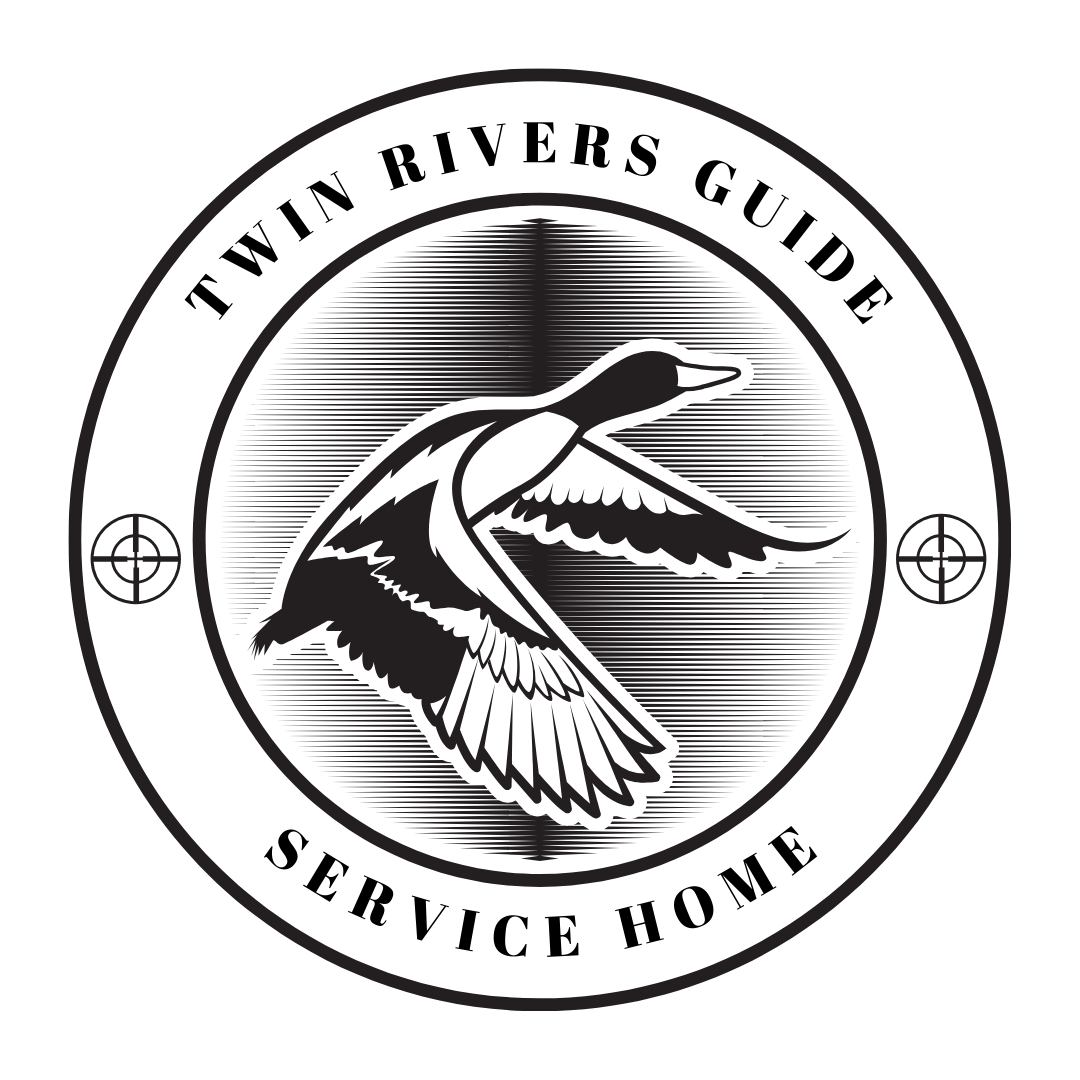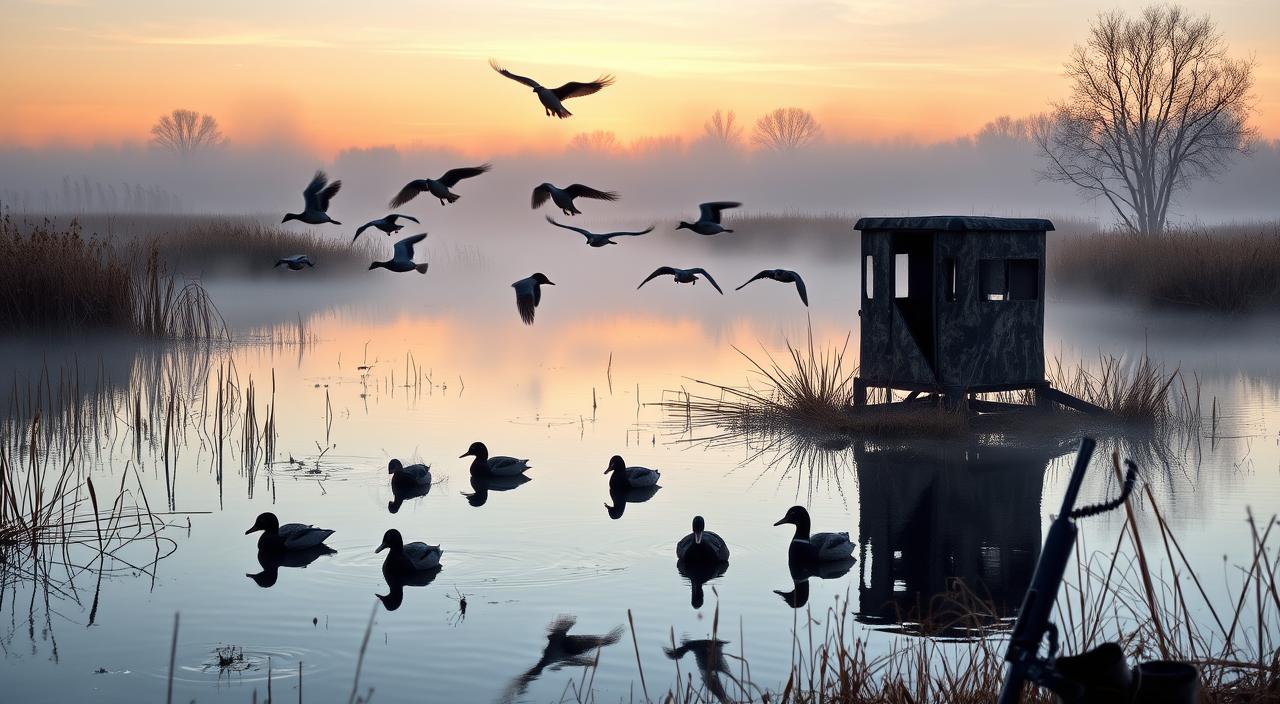Waterfowl hunting is both challenging and rewarding. It needs the right strategies and techniques. Having the right gear and understanding effective methods can make a big difference.
Choosing the best locations and understanding waterfowl behavior are key. With the right gear and techniques, hunters can improve their skills. This makes them more confident in the field.
Following proven tips and staying updated on gear can elevate your skills. Whether you’re experienced or new, knowing effective techniques is crucial. It ensures a rewarding hunt.
Essential Waterfowl Hunting Gear for Success
Having the right gear is key for a successful waterfowl hunt. You’ll need shotguns, ammunition, waterproof clothes, waders, duck calls, and basic calling tools. It’s important to pick the right gear and know how to use it well.
Start by finding the best places to hunt waterfowl. Knowing what gear you need for each spot helps you choose wisely. For example, wetlands require waterproof clothes and waders to stay dry.
When picking gear, think about your shotgun and ammo, and the quality of your duck calls. Good gear and practice can lead to a successful hunt. It’s all about making the most of your time in the field.
It’s also vital to keep up with the latest gear and trends. Attend workshops, read hunting magazines, and join online forums. This way, you’ll know the best gear and connect with other hunters.
Understanding Waterfowl Behavior and Patterns
To be a great waterfowl hunter, knowing how they behave is key. Learning about their migration and feeding habits can boost your success. Each species migrates at its own time, so knowing these patterns helps plan your hunt.
Waterfowl follow habits, especially when it comes to food. They often gather in wetlands, fields, and ponds. By finding these spots, you can set up your hunt where they are most likely to be. Observing waterfowl behavior also reveals their social ways, like mating and flocking.
Here are some tips for watching waterfowl:
- Look for patterns in their migration and feeding
- Watch how they interact with others
- Learn to spot different species and their traits
By following these tips, you can get better at hunting waterfowl. This will help you have a more successful hunt.
Knowing waterfowl behavior and patterns is vital for hunting them. By studying their ways, you can create smart hunting strategies. Always hunt safely and ethically, and respect their natural homes.
Choosing Prime Hunting Locations
To have a successful hunt, picking the right waterfowl hunting spots is key. This means finding productive wetlands, using scouting techniques, and understanding weather. By knowing these, hunters can make smart strategies and set up a winning decoy setup.
When looking for top spots, think about these things:
- Wetland types, such as marshes, swamps, or flooded fields
- Water levels and quality
- Vegetation and food sources
- Wildlife activity and bird patterns
Scouting is important for finding the best places. Hunters should watch bird behavior, note the weather, and find good hunting spots. By using these tips, hunters can plan a successful hunt in the best locations.
Understanding weather patterns is also crucial. Weather affects bird behavior and hunting success. By knowing how weather impacts waterfowl, hunters can adjust their plans and decoy setup for a better hunt.
Mastering Decoy Placement Strategies
To up your chances of a successful hunt, knowing about waterfowl hunting decoy setup is key. A well-thought-out decoy setup can draw waterfowl to your spot. Think about the waterfowl you’re after and the area’s terrain. For ducks, use decoys that look like they’re swimming or feeding.
Creating a believable decoy spread is crucial. Mix different decoy types, like full-body, shell, and silhouette decoys. Also, place decoys with the wind and sun in mind. This makes your spread look natural, drawing waterfowl to you.
- Choose realistic and sturdy decoys.
- Arrange decoys to look natural.
- Use motion decoys to mimic movement.
- Change your decoy setup with the day and weather.
By using these tips and honing your decoy placement, you’ll boost your hunting success. Always follow successful waterfowl hunting tips and rules for a safe, fun hunt.
Advanced Waterfowl Hunting Tips for Experienced Hunters
Experienced waterfowl hunters know how to keep up with their prey. They use advanced techniques, tactics, and strategies to hunt better. One key skill is making complex calls to sound like different birds.
Good hunting strategies mix calling, decoy placement, and staying hidden. Hunters use wind direction to position themselves for better shots. They also read bird behavior to guess their next move. Knowing bird habits and adapting to changes is key.
- Using multiple calls to create a sense of urgency and attract birds
- Positioning decoys to create a natural-looking spread
- Reading the body language of birds to anticipate their behavior
Experienced hunters can improve their skills with these advanced strategies. This makes their hunts more successful and fun.
Seasonal Hunting Adjustments
As seasons change, so must waterfowl hunting strategies for success. Waterfowl hunting techniques that work early on may not in the late season. Hunters need to adjust for weather, bird behavior, and habitat changes.
To stay flexible, hunters use various waterfowl hunting strategies. They might change decoy spreads or calling techniques for different weather. Adapting to changes can boost their hunting success.
- Adjusting decoy spreads to account for changing bird patterns
- Using different calling techniques to attract birds in different types of weather
- Changing hunting locations to account for changes in habitat conditions
By considering these factors and adjusting theirwaterfowl hunting techniques, hunters can stay ahead. This way, they can have a successful hunt, no matter the season.
Building an Effective Blind Setup
Waterfowl hunting requires a well-hidden blind for success. A good blind helps you get closer to your target. This section will cover the importance of a hidden blind and how to set one up. We’ll talk about natural and artificial blinds and how to stay hidden.
Choosing the right blind is key. You can pick from natural or artificial blinds. Natural blinds use materials like grasses and leaves. Artificial blinds use camouflage netting. The choice depends on your hunting style and location.
Natural Blinds
Natural blinds blend in with the surroundings. They’re made from local materials like grasses and leaves. They’re cheap and easy to set up but may not last long.
Concealment Techniques
Using the right blind is just the start. You also need to stay hidden. Wear camouflage and face paint to blend in. Stay still and quiet to avoid scaring birds away. A hidden blind and good concealment techniques can lead to a successful hunt.
- Choose a good location for your blind.
- Use natural or artificial materials for your blind.
- Make sure your blind is well-hidden.
- Stay still and quiet while hunting.
By following these tips, you can create a great blind setup. This will help you succeed in waterfowl hunting. It will also improve your hunting experience with the right gear and tactics.
Shot Timing and Targeting Techniques
Getting the shot right is key to a good waterfowl hunt. Waterfowl hunting techniques mean knowing the birds’ habits and when to shoot. Hunters should practice and watch closely to guess the birds’ next move.
For targeting, waterfowl hunting strategies are important. Hunters must know the bird’s type, age, and how far away it is. This helps decide when to shoot. Important things to think about include:
- Species identification
- Distance and speed estimation
- Shot placement and angle
Learning these waterfowl hunting techniques and waterfowl hunting strategies
Conservation and Ethical Hunting Practices
As waterfowl hunters, we must follow conservation and ethical hunting practices. This helps keep the sport alive for the future. We need to know and stick to bag limits and regulations. These rules stop overhunting and protect waterfowl numbers.
Good waterfowl hunting strategies and waterfowl hunting techniques are key. They help us hunt without harming the environment. We should also pick waterfowl hunting gear recommendations that are eco-friendly. Important choices include:
- Using non-toxic shot and lead-free ammunition
- Respecting habitat and avoiding sensitive areas
- Following local regulations and guidelines
By following these rules, we help protect waterfowl and their homes. This way, we ensure the sport stays alive for others to enjoy in the future.
Weather Impact on Waterfowl Movement
Understanding how weather affects waterfowl movement is key for good waterfowl hunting strategies. Weather changes how waterfowl behave and migrate. So, it’s important to adjust your waterfowl hunting techniques based on the weather.
When looking at weather, consider wind direction, temperature, and rain. For instance, a cold front can make waterfowl move, while a warm front can make them more active. Knowing these patterns can help hunters have a better hunt.
Here are some tips for adjusting waterfowl hunting strategies based on weather:
- Use wind direction to your advantage by setting up decoys and blinds in areas where waterfowl are likely to be funneled by the wind.
- Take advantage of changing weather patterns to locate waterfowl, such as during a cold front or after a storm.
- Adjust your waterfowl hunting techniques to match the weather conditions, such as using louder calls during windy conditions or softer calls during calm conditions.
By using these tips in your waterfowl hunting strategies and waterfowl hunting techniques, you can improve your chances of a successful hunt. This will help you make the most of your time in the field.
Dog Training for Waterfowl Retrieval
Training a dog for waterfowl retrieval is key in waterfowl hunting. A well-trained dog makes hunting more fun and efficient. Start with basic commands like sitting, staying, and coming when called.
Once the dog knows basic commands, teach water retrieval. This means teaching the dog to get game from the water. Use decoys and simulated hunts to get them ready for real hunting.
Basic Commands and Skills
- Teach basic obedience commands, such as sit, stay, and come
- Introduce water retrieval techniques, such as retrieving game in the water
- Use positive reinforcement training methods to encourage good behavior
Using the right gear and strategies can boost hunting success. A trained dog is a big help, retrieving game and enhancing the hunt. With patience and positive training, dogs become great retrieval partners.
Conclusion
Successful waterfowl hunting mixes tactical knowledge, keen observation, and dedication. With the right strategies and techniques, you’re set for rewarding hunts.
The path to becoming a skilled waterfowl hunter never ends. Keep improving your skills and watch the birds closely. Always hunt responsibly and with care for nature. With effort and patience, you’ll fully enjoy this exciting outdoor activity.
So, get ready, go out, and start your waterfowl hunting journey. May your time outdoors be filled with excitement, success, and a deep love for nature.

